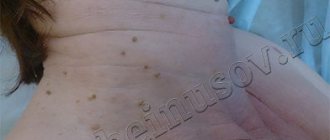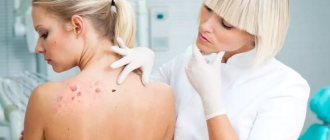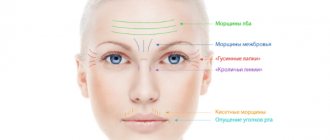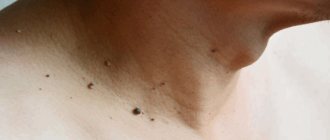What are papillomas and how to treat them?
September 13, 2019
Papillomas are small skin growths that can protrude above the surface of the skin. They can appear anywhere on the body and are especially common in areas where the skin is subject to friction - for example, in the folds of the neck where there is friction from a chain or clothing.
Other names for papilloma: acrochordon, cutaneous papilloma, skin wart, fibroepithelial polyp, fibrous molluscum, soft fibroma.
Skin papillomas are widespread and usually appear in people after 25 years of age. They occur equally in men and women.
Why do they appear?
Like warts, papillomas are not dangerous
.
Their appearance is associated with the human papillomavirus (HPV),
which is transmitted through contact with a carrier. It is also possible to transmit HPV from an affected area of skin to a healthy one in one person. High humidity and microcracks in the skin increase susceptibility to viral particles. In this regard, you should always use personal hygiene items when visiting swimming pools, saunas and showers.
Important:
a large number of papillomas may indicate problems with the immune system.
For women in such cases, it is necessary to take a smear for HPV, since some of its types can cause cervical cancer
Systemic treatment of warts
When warts appear on the elbows, they can be easily removed.
But in 30% of patients they reappear.
To prevent relapse, as well as to prevent complications (including squamous cell skin cancer), the patient is prescribed systemic therapy.
Warts often appear, increase in size and number, and recur after removal in people with reduced immunity.
In addition, human papillomavirus infection itself negatively affects the state of the immune system.
Therefore, it is important not only to remove a wart on the elbow - this is only a symptom of the disease - but also to remove the virus from the body.
Various drugs are used for this:
- immunomodulators
- general antiviral agents
- local injections of interferons
- enzyme therapy
- prebiotics
- antioxidants
Numerous studies show that this approach increases the effectiveness of therapy and reduces the risk of recurrence of warts on the elbows.
What is the best way to treat?
A large number of papillomas certainly causes inconvenience and does not look aesthetically pleasing. However, this is not a reason to use old-fashioned methods for removal with thread, pliers or a blowtorch.
For single small (1x1 mm) formations, celandine juice
- a proven folk remedy.
When there are many papillomas or they are large, this method is not suitable
, as it can last for months and lead to severe inflammation.
Removal using radio wave surgery is much more convenient and effective
The operation does not require special preparation, is practically painless, and after it you can drive a car.
Once I had the opportunity to remove about 70 papillomas from one patient at once. It is difficult to convey all the joy of a person who got rid of them, whom they tormented for several years.
How to get rid of warts on elbow at home?
Some people try to get rid of warts on their own.
This is possible, but very risky.
It’s worth saying right away that most of the methods that are recommended to you on the Internet are ineffective, unsafe or painful.
Including:
- conspiracies;
- tying with threads;
- impact on education by apple, celandine, ice, potatoes, rowan porridge, etc.;
- treatment with hydrogen peroxide, acetic acid, iodine, alcohol.
Real ways to get rid of warts at home:
- buy podophyllotoxin (Condilin) at the pharmacy and apply it for several weeks, intermittently, according to the scheme indicated in the instructions;
- buy Solcoderm or a similar product at a pharmacy and remove the wart using a chemical method (the drug is dangerous and is intended exclusively for medical use);
- buy a cryosystem at the pharmacy for home removal of warts with liquid nitrogen (for example, Wartner Cryo).
You need to understand that home methods for removing formations on the elbow are less reliable and not always safe.
Hundreds of negative reviews have been published on the Internet about Wartner Cryo.
It causes frostbite and inflammation of the skin, but often does not get rid of the wart.
It is unsafe to apply concentrated solutions of alkalis and acids to the elbow.
Because the location is inconvenient, you can burn healthy skin.
For some, the marks remain for life, which creates an even greater aesthetic defect than the wart itself.
The safest method is cytotoxic.
It is not always effective, but sometimes a person actually manages to remove a small wart on the elbow in this way.
You need to continue using the drug until it disappears completely, but no more than 5 weeks.
If the wart has not disappeared within this period, you should use another, more effective method.
Home removal has some disadvantages:
- you do not have experience, so the procedure may be performed incorrectly, which reduces its effectiveness;
- Exposing a wart to a chemical or liquid nitrogen for too long can lead to damage to the deeper layers of the skin and the formation of scars;
- even with not very prominent, but extensive scar changes in the skin, the function of the elbow joint may be impaired;
- warts are often not completely removed or recur;
- People often burn the skin next to the wart with chemicals, and the marks can remain for life.
Treatment results
The photo below shows the results of removal of neck papillomas using radio wave surgery
Rarely occur again. Reappearance of papillomas is possible with high virus activity in the body. In this situation, additional treatment with immunomodulators or consultation with an immunologist may be required.
Diagnosis of warts on the elbow
When a wart appears on the elbow, diagnostic procedures are not required in most cases.
Such a wart can be removed without even undergoing any tests.
In some situations, which are listed above, the doctor may recommend a histological examination of the formation.
In this case, it should be removed surgically or radio wave, or using electrocoagulation.
The removed wart is sent to the laboratory for examination, which will determine whether there are signs of malignant degeneration.
If excessively large or multiple skin lesions appear on your elbows, your doctor may recommend an immunogram.
This is a blood test for indicators of the immune system.
Usually, an unfavorable course of human papillomavirus infection indicates immunodeficiency.
Based on the results of the immunogram, the immunologist can prescribe treatment.
Within a few months it will improve your immune system.
Often such therapy leads to the cure of human papillomavirus infection.
Forecast
The prognosis for life with diagnosed gout is favorable. Most patients with the disease live to old age. The quality of life improves by following measures to prevent relapses of the disease and undergoing regular examinations by a doctor.
You can get tested for gout at the Yusupov Hospital. The clinic is located in Moscow. The hospital’s equipment makes it possible to accurately determine gout at the initial stages of development. After receiving the research results, experienced doctors develop individual treatment tactics. Modern therapy helps to quickly alleviate the patient's condition. The drugs used meet quality and safety standards. To make an appointment with a rheumatologist, call the contact center of the Yusupov Hospital 24 hours a day, any day of the week.
Make an appointment
Wen on the body: reasons, how to get rid of it
A small growth on the skin, a pea-sized “nodule”, can cause anxiety and concern. Concerns increase if the formation begins to gradually increase in size. The specialist’s diagnosis of lipoma only adds fuel to the fire of worry, since it is very similar to the name of many dangerous malignant tumors.
In fact, there is no real reason for concern, since wen extremely rarely (almost never) degenerates into a malignant neoplasm. This is a benign tumor that is characterized by slow growth or stable size over a long period of time. Why wen appears on the body and how to deal with them, you will learn from the publication presented to your attention.
What is a wen?
Wen is an unofficial, “folk” name for a subcutaneous formation formed by adipose tissue. In official medicine, the scientific term “lipoma” is used, which reflects the histological composition of the tumor.
Lipoma is a benign tumor that remains as such throughout its existence. A wen on the body is not characterized by malignant degeneration. From this point of view, it does not pose a health threat. The problem is mainly of an aesthetic nature, especially if the tumor is located on an open area of the body - on the face, on the neck, on the skin of the distal parts of the arms.
A distinctive feature of any benign tumor is that it is formed from cells surrounded by a fibrous capsule. In this way, wen on the body differs from atheroma - another neoplasm, the appearance of which is caused by fat. Atheroma is an accumulation of sebum secreted by the sebaceous glands. Atheroma is formed due to blockage of the ducts of the sebaceous glands. The secretion of the gland cannot come out, accumulates under the skin and manifests itself in the form of a small or medium-sized formation that rises above the skin.
Lipoma, unlike atheroma, does not consist of the secretion of the sebaceous glands, but of fat cells surrounded by a capsule of connective tissue. A skin formation appears as a result of abnormally active division and growth of adipocytes. All cells, regardless of the size of the wen, remain differentiated, that is, they retain their typical characteristics, which makes it easy to distinguish a lipoma from a malignant tumor. A cancer tumor is characterized by impaired differentiation and atypical cell structure. In the case of lipoma, these signs of malignancy are not present.
Lipoma is a benign tumor of adipose tissue, which consists of differentiated adipocytes surrounded by a fibrous capsule. Malignant degeneration is not typical for wen on the body; they do not pose a danger to health or life.
Reasons for the appearance of wen
Numerous studies devoted to the problem discussed in the publication have not made it possible to establish a single cause of lipomas. Currently, it is generally accepted that a wen on the body appears as a result of the combined action of a number of predisposing factors, among which endogenous causes predominate.
Among the risk factors, the most important role is played by metabolic disorders associated with enzymatic deficiency. Particularly dangerous in this regard are disorders affecting the biochemical mechanisms of lipid and carbohydrate metabolism. The cause of lipoma can be hormonal disorders not related to the pathology of the endocrine system. In particular, in women, a neoplasm can appear during pregnancy, lactation or after the end of the lactation period.
Endocrine diseases are also among the risk factors. If a person has wen on the body, the reasons should be sought in the functioning of the hormonal system. Dysfunction of the pituitary, adrenal, thyroid (hypothyroidism) or pancreas (diabetes) may be the root of the problem. A risk factor is an imbalance in the secretion of sex hormones, which is important for women taking oral contraceptives and athletes using pharmacological agents to accelerate results.
A fatty deposit on the body can occur even against the background of complete well-being, that is, in the absence of any endocrine disorders, hormonal changes or metabolic problems. Doctors explain this by genetic predisposition: people whose relatives have encountered a similar problem have a higher risk of developing lipoma. Hereditary, or familial, lipomatosis is characterized by the appearance of multiple wen at a young age.
Among exogenous factors, nutrition is of greatest importance. The risk of lipoma is higher if a person's diet is dominated by simple carbohydrates (sugar, confectionery, flour), as well as saturated and hydrogenated fats. A risk factor is systematic alcohol consumption. All these substances interfere with the natural course of metabolic processes, which is fraught with the formation of a benign tumor of adipose tissue.
Another possible cause of the appearance of a wen on the body is mechanical trauma, which leads to neurotrophic disorders in the integumentary tissues. They, in turn, can provoke the proliferation of subcutaneous fat cells. It is possible that exposure to ultraviolet radiation on the skin plays a certain role, but the connection between this factor and the appearance of lipomas has not been proven.
Localization, appearance, symptoms
The concept of “typical localization” does not apply to wen on the body. The tumor can appear on any part of the body: on the back of the foot or hand, on the shoulder or forearm, on the back, on the chest, on the face or on the abdomen. In short, lipoma does not have a “favorite” location; the tumor can appear anywhere.
As for the symptoms, that is, the appearance of the tumor, there is more certainty. Externally, the lipoma looks like a pea; it is characterized by a rounded shape with regular and even edges. On palpation, the adipose tissue tumor is soft or moderately dense. The surface is smooth. The color can be flesh-colored, reddish or brownish, depending on how abundantly blood vessels grow into the tumor.
An important diagnostic criterion is the mobility of the tumor. The subcutaneous wen on the body is always mobile; it is not fused to deeper tissues and moves freely with the skin. This symptom makes it easy to distinguish a lipoma from a malignant tumor. The latter grows into deep tissues, which is why it becomes immobile.
Size is difficult to use as a diagnostic criterion because it can vary over a wide range. Typically, a fatty tissue tumor has a diameter of 0.5 to 1 cm, but there may be exceptions to this rule. Wen on the body can reach 2-3 cm in diameter. There are cases when, as a result of growth, a lipoma reached gigantic sizes - more than 10 cm in diameter.
The last symptom - pain - is not typical for wen. As a rule, education does not remind us of itself. The exception is situations when a person mechanically injures him. When struck, scratched or pinched, a sharp pain may occur, which is not too intense and passes quickly. However, if a tumor of adipose tissue puts pressure on superficial vessels and nerves, the clinical picture may include moderate or even severe pain.
Are wen dangerous?
As already mentioned, the prognosis for this benign tumor is extremely favorable. The neoplasm is not characterized by malignant degeneration, so nothing threatens life. However, this does not mean that you can forget about lipoma, since certain health risks are still present.
In case of mechanical damage (cut, pinching, blow) inflammatory processes may begin in the depths of the formation. If the integrity of the skin is damaged, there is a risk of infection in the wound. The result of this may be the development of a necrotic or purulent-inflammatory process, after treatment of which visible scars will remain on the skin.
Scars can also form after removal of a large tumor. A small lipoma can be removed without leaving a trace, so that there are no noticeable scars left on the skin. When removing large and giant wen, it is difficult to avoid scar changes. Meanwhile, large wen must be removed, since sooner or later they will begin to put pressure on the nerves and blood vessels. It follows from this that it is better to get rid of the wen at an early stage, before it grows to a large size, the only question is how to do this?
How to get rid of wen?
Many people, in an attempt to get rid of the tumor, resort to traditional medicine recipes. Numerous publications devoted to this problem offer various remedies: compresses made from onions, garlic or sprouted wheat, applications of celandine and other medicinal herbs. Unfortunately, such an approach is doomed to failure; it is not possible to get rid of education using folk remedies. Traditional recipes are unlikely to provoke the growth of a lipoma, but they certainly will not lead to a reduction in its size.
Official medicine offers two options for solving the problem. You can get rid of small lipomas using a minimally invasive procedure, which involves injecting a special solution deep into the formation that destroys adipocytes. The disadvantage of this method is that there is a high risk of relapse, the capsule is not removed, and the method can only be used for small (up to 2-3 cm) tumor sizes.
Surgical removal of a wen on the body is an effective and universal treatment method. The lipoma is removed along with the surrounding capsule. Minor surgery is performed using a traditional, radio wave or laser scalpel. Accordingly, traditional surgical, radio wave and laser removal are distinguished.
All methods of surgical treatment are effective, but from an aesthetic point of view they are not equivalent. After traditional surgical removal of a tumor, small scars often remain, even if the doctor removes a small tumor. Radio wave surgery allows you to minimize the severity of scars, and the laser method makes it possible to perform the operation absolutely without leaving a trace.
Laser lipoma removal has many benefits. The laser knife seals the vessels immediately after they are damaged, reduces bleeding, and injures the skin to a lesser extent. Since laser pulses have a detrimental effect on pathogenic and opportunistic microflora, there is no risk of infectious complications. In addition, the laser stimulates regeneration, which shortens the recovery period, accelerates skin healing and avoids scar formation.
The problem is that the laser method is used only for medium-sized and small-sized wen; large and gigantic ones (more than 10 cm in diameter) are forced to be removed by the doctor using the traditional surgical method. Given their size, it is almost impossible to avoid scar formation.
Since the aesthetic component of the operation is a concern for all patients, doctors recommend removing lipomas in the early stages. The deciding factor is the size of the education. A tumor on the face can be removed without a trace if its diameter does not exceed 1 centimeter. Wen on the body are removed without scarring if their size is no more than 2.5-3 cm.
Laser removal of wen is the most effective and safe method. It is better to remove lipomas in the early stages, when their size does not exceed 1 cm if localized on the face or 3 cm if localized on the body.
The operation is performed on an outpatient basis under local anesthesia; only giant lipomas require the use of general anesthesia (anesthesia). The patient returns home on the day of surgery. During the recovery period, it is necessary to protect the skin from ultraviolet rays and avoid exposure to high or low temperatures. It is advisable not to wet the wound with water and regularly treat it with antiseptic solutions.
Removal of fatty tissues on the body: price
Surgeries to remove fatty tissue are carried out in aesthetic medicine and plastic surgery clinics. It is advisable to contact a medical institution equipped with modern equipment for laser manipulation.
The price of removing wen with a laser is low.
The exact cost depends on the size of the education. The cost of removing a small lipoma (up to 3 cm) in Moscow clinics is about 5 thousand rubles. The cost of treating a tumor up to 10 cm in size increases to 8-9 thousand rubles. Treatment of large and giant lipomas costs more - up to 15 thousand rubles, depending on the size of the formation and the category of complexity of the operation. You will receive more detailed information about lipoma removal methods during a consultation with a doctor at the Galaktika aesthetic medicine clinic (Moscow)
Classification
Depending on the nature of the course of the disease, primary gout is distinguished - an independent disease that occurs against the background of exposure to provoking factors, and a secondary form of the disease, which develops against the background of concomitant pathology. Based on the prevalence of the pathological process, gout is divided into the following types:
- Monoarticular arthritis. Urates accumulate in the area of one joint. Characteristic of the onset of the disease. The most common site of monoarticular arthritis is the big toe joint;
- Polyarticular arthritis. Inflammation affects more than 2 joints. Polyarticular arthritis is characteristic of chronic gout. Localized in the joints of the elbows, wrists, legs, feet and hands.
Make an appointment
Treatment of skin papillomas
Since skin tags are generally harmless, their removal is usually done for aesthetic or cosmetic reasons.
Large skin tags - especially those located in areas subject to friction from clothing, jewelry or skin - may be removed due to their frequent irritation.
Removal of papillomas occurs under local anesthesia, is painless and does not leave behind scars or scars.
The procedure for removing papillomas is carried out by a dermatologist or cosmetologist after diagnosing the tumor. In some cases, histological examination of removed papillomas may be required.
Symptoms in men
At the initial stages of the disease, there are no clinical signs of gout in men. During preventive examinations or examinations for other pathologies, a biochemical blood test detects an increased level of uric acid - hyperuricemia.
The first sign of gout in men that forces you to see a doctor is pain in the joints. Acute gouty arthritis at the initial stage is most often short-term. The attack develops suddenly, mainly at night. The pain syndrome is intense, constant, pronounced. Target joints affected:
- big toe;
- Thumb;
- Knees;
- Elbows;
- Ankle.
The skin over the joint is hyperemic, swollen, and hot to the touch. The joint is limited in movement, since any mobility provokes increased pain. After a few days, the pain goes away, and the patient returns to his usual way of life.
Further progression of the disease leads to a longer exacerbation of gout symptoms in men, and periods of calm are constantly decreasing. Over time, periods of remission are completely absent, and the pain becomes chronic.
In the stage of chronic arthritis, urates are deposited in connective tissue, organs in the form of nodules, which are called tophi. Deposition of urate in the kidneys is the cause of urolithiasis. Sometimes kidney inflammation develops.
Expert opinion
Author:
Elena Yurievna Panasyuk
Rheumatologist, doctor of the highest category, member of the Association of Rheumatologists of Russia
According to WHO data, 5-20% of Russian residents suffer from pathological accumulation of monosodium urate crystals. They are at risk of developing gout. The disease is registered in 0.1% of the population. Similar statistics in Europe and the United States indicate a more deplorable situation.
The number of newly diagnosed cases of gout is growing every year. The main role among the reasons for the early onset of the disease is given to a person’s lifestyle. The prognosis for recovery and quality of life after diagnosis depends on the stage at which the pathology is diagnosed. Severe gout can cause loss of self-care and normal skills. Late access of the population to a doctor is associated with the absence of a specific clinical picture of the disease in the early stages of development.
Doctors at the Yusupov Hospital perform differential diagnostics, which makes it possible to determine the diagnosis. An individual approach to each patient is necessary to select the correct therapy. The doctor’s tasks include relieving symptoms of gout exacerbation and preventing relapses. For this purpose, the Yusupov Hospital prescribes modern drugs that have passed quality and safety control.
Reasons for the development of the disease
Hyperuricemia is the main cause of gout. This condition occurs in the following cases:
- Obesity. The diet of a gout patient included an excessive amount of fatty foods, simple carbohydrates and high-calorie foods. In addition, eating large amounts of meat increases the risk of developing gout;
- Alcohol abuse;
- History of psoriasis and hypertension;
- Hereditary predisposition.
An increase in the concentration of uric acid occurs as a result of the fact that healthy kidneys are not able to filter its sharply increased amount. Kidney pathology does not allow them to process even normal amounts of uric acid.
What are skin papillomas?
Skin papillomas are benign tumors consisting of skin cells.
They can appear in the following areas:
- on eyelids;
- in the armpit area;
- under the breast;
- in the groin area;
- on the skin of the upper chest;
- on the neck.
Papillomas often go unnoticed unless they are located in a visible place or are not subject to mechanical stress, such as friction from wearing clothes and jewelry or shaving.
Often people do not experience any inconvenience if they have papillomas, while the latter can become malignant. They become more noticeable when they reach a large size, or if painful sensations appear when rubbed at the locations of the papillomas. If damaged, papillomas can become inflamed and bleed.
Initially, skin papillomas are quite small, but gradually they grow and can reach large sizes.











